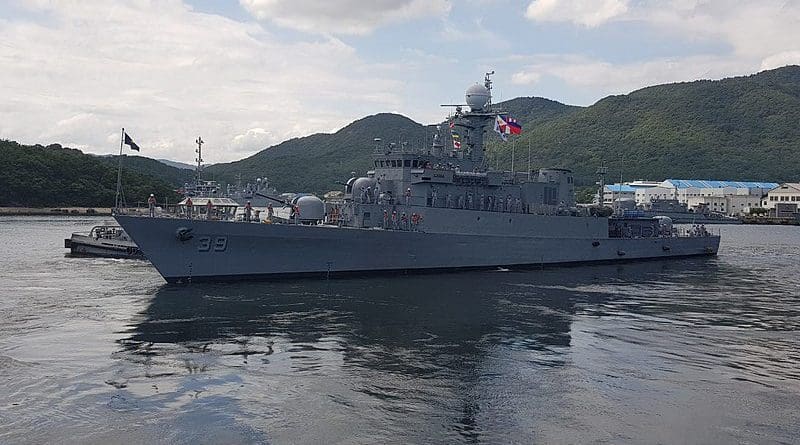Rethinking The Philippines’ Submarine Program – Analysis
By Abdul Rahman Yaacob*
Since 2013, the Philippine Navy has sought to replace its obsolete assets with newer platforms as part of a military modernisation program initiated by former president Benigno Aquino and continued by the current administration under President Rodrigo Duterte.
The Philippines is keen to include submarines in its naval inventory. The introduction of submarines would expand Philippine Navy’s capabilities into the sub-surface domain and allow it to conduct stealth operations and introduce elements of uncertainty into its engagements with hostile naval forces. Being difficult to detect, they are also suited for intelligence, surveillance and reconnaissance missions.
If the Philippine Navy decides to acquire submarines, it needs to consider the all the associated costs beyond the capital acquisition expenditure, such as berthing and training facilities, annual operations and training and maintenance. The recent sinking of an Indonesian submarine further highlights the need to invest in submarine rescue capabilities.
Any submarine-related acquisition will consume considerable financial resources, which are already impacted by the ongoing COVID-19 pandemic. The pandemic has already led the Philippines to shelve several military modernisation projects. It is unlikely the Philippine economy will recover in the foreseeable future given that COVID-19 cases in the country have escalated once again since mid-March.
Given the Philippines’ economic uncertainty, should the submarine acquisition program be reassessed? To answer the question, there is a need to consider the most pressing security risk facing the Philippines and the current capabilities of the Philippine Navy to manage it.
Arguably, the most pressing security risk for the Philippines in the short and medium-term is the protection of its Exclusive Economic Zone (EEZ), which covers more than 2 million square kilometres. To protect its EEZ, a possible strategy is to maintain a persistent naval presence throughout the contested maritime domain.
A persistent naval presence serves two purposes — deterrence and detection. Unlike a submarine, a surface platform patrolling and maintaining a presence within a specific area would act as a deterrent against hostile foreign powers intending to challenge the Philippines’ control over its EEZ. If deterrence fails, Philippine Navy vessels in the area could quickly raise the alarm to any immediate threats to the Philippines’ maritime security.
The Philippine Navy’s tactic at Second Thomas Shoal reflects the importance of persistent naval presence in disputed waters. In 1999, the Philippine Navy grounded a Second World War-era vessel on the feature to stake its claim, a strategy that arguably worked as China could not exert complete control over the feature. By contrast, the nearby Mischief Reef has been turned into a Chinese military installation.
Despite its modernisation programs, the Philippine Navy’s current fleet of 64 surface and patrol combatants is insufficient to cover the country’s EEZ. This situation has been exploited by hostile foreign powers to erode the Philippines’ access and control over its own EEZ in the South China Sea, as seen during the recent incidents at Whitsun Reef and Scarborough Shoals in 2012. There, the absence of the Philippines’ naval presence meant it was caught off guard when China deployed fishing ships to stake its claims over these features.
In terms of capabilities, the Philippine Navy’s ability to meet modern naval threats is debatable. Its current surface fleet has limited missile capabilities and is ill-equipped to conduct modern naval warfare. The latest inclusion of two missile frigates does not bolster PN’s capabilities significantly. These frigates will only be fully armed with surface-to-surface and surface-to-air missiles between late 2021 and early 2022.
The goal of any defence acquisition program should be to identify affordable equipment or platforms to best address a country’s security risks. Faced with challenges over the control of its EEZ and a limited budget in the immediate and medium terms, the Philippines’ defence planners should consider the following factors when assessing if any acquisition of submarines best serves the Philippine Navy’s mission. Are submarines the best option to deter Chinese fishing vessels from swarming and taking over features within the Philippines’ EEZ? Would cheaper surface platforms in greater numbers serve this purpose? Does the Philippine Navy have the resources to sustain any new capabilities in the long run?
In its current state, the Philippine Navy does not have the ability to maintain a persistent naval presence throughout the contested maritime domain due to insufficient surface platforms. Diverting limited resources to acquire submarines, instead of building up adequate and capable surface platforms, may run contrary to the Philippines’ maritime security interests. A lack of experience with submarines means it will be several years before they will be operationally ready. Given the urgency of threats to its maritime interests and financial constraints in the immediate and medium-term, the Philippine Navy should first seek to strengthen its surface fleet, both in terms of numbers and capabilities.
*About the author: Abdul Rahman Yaacob is a PhD candidate at the National Security College, The Australian National University.
Source: This article was published by East Asia Forum

